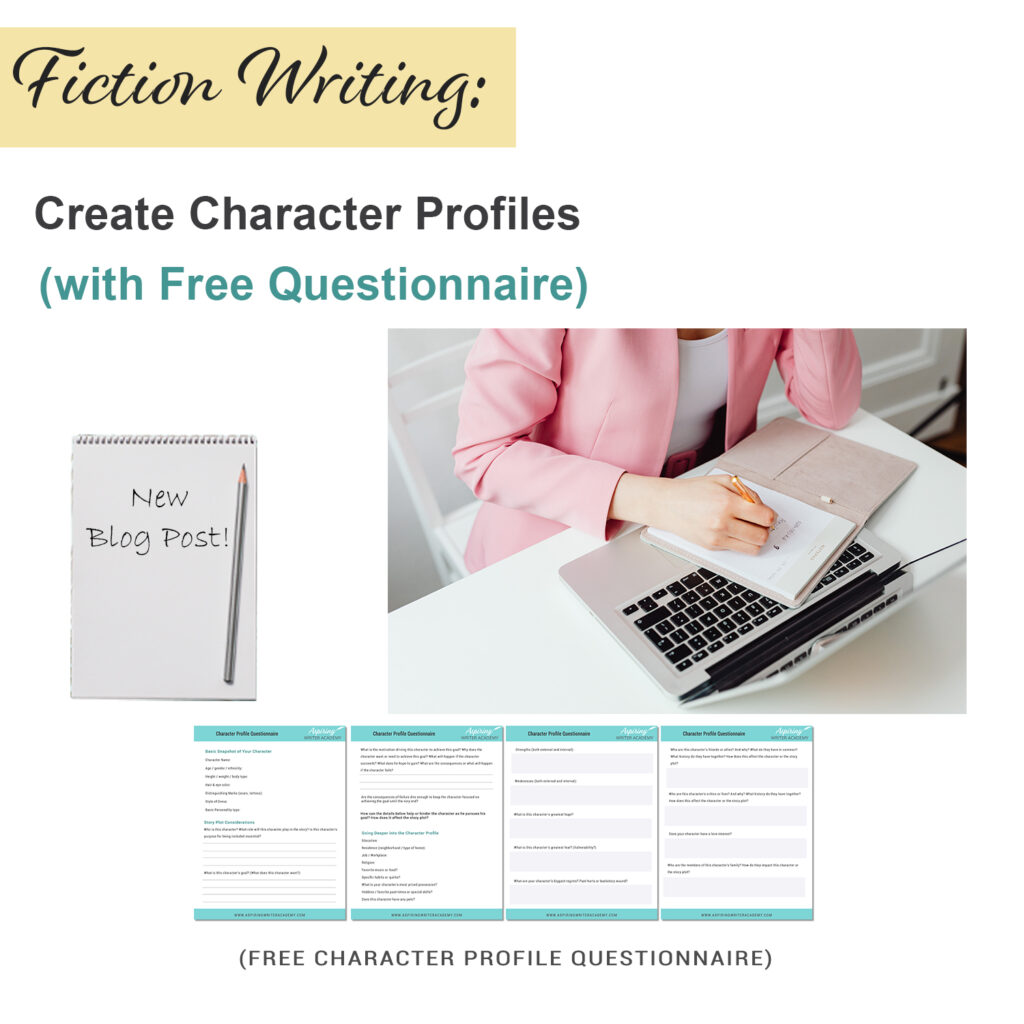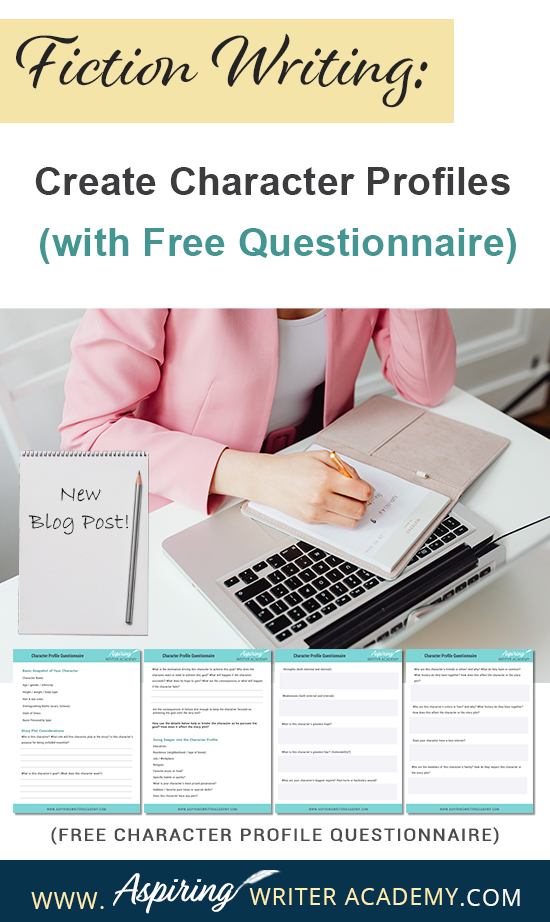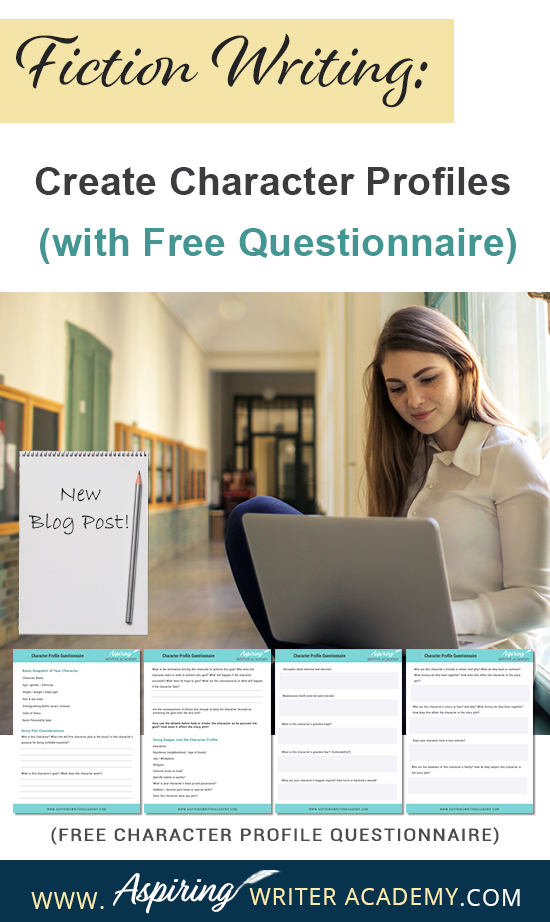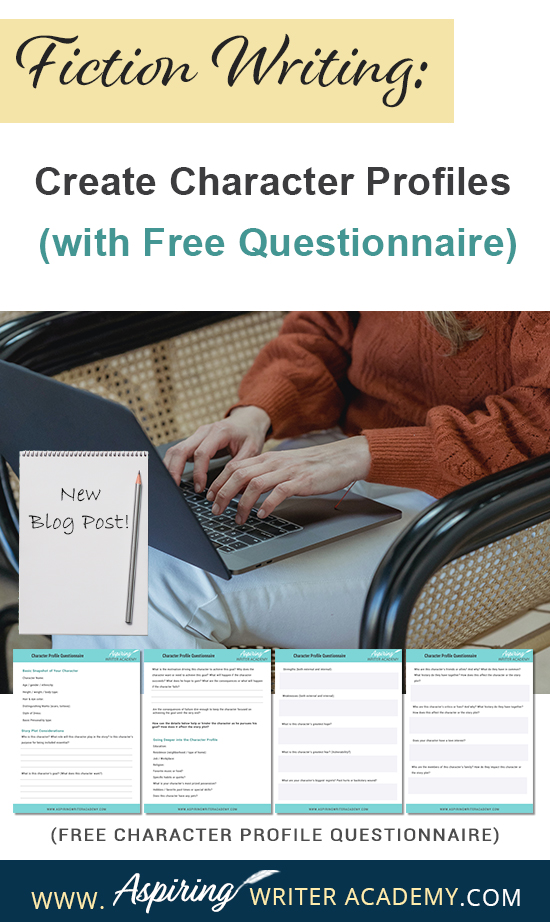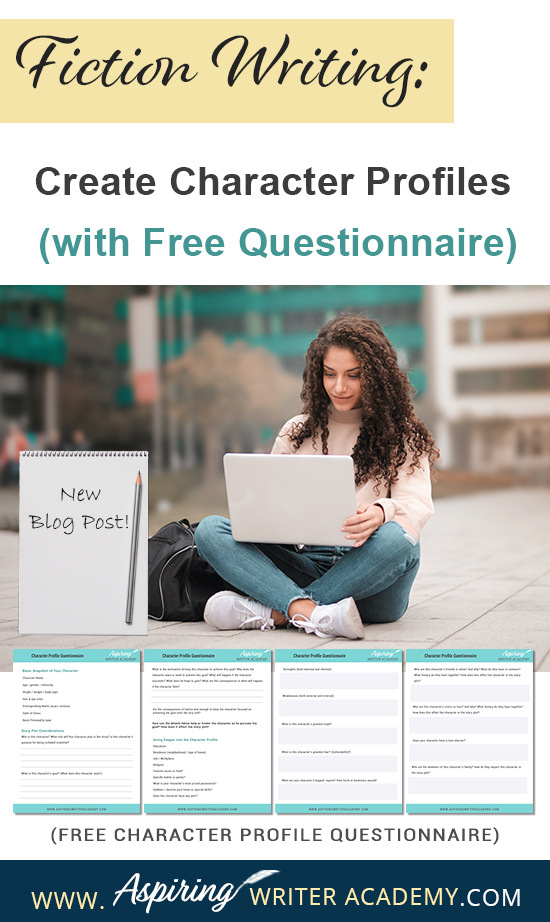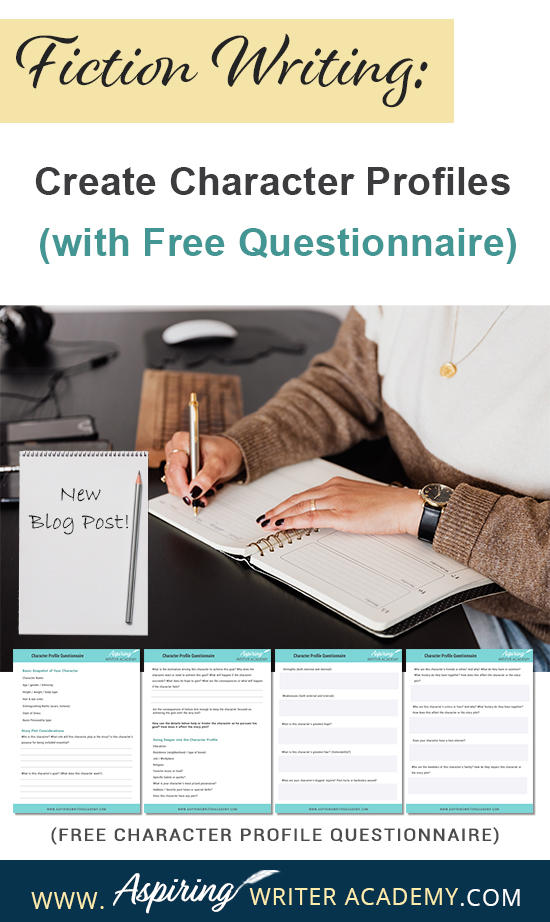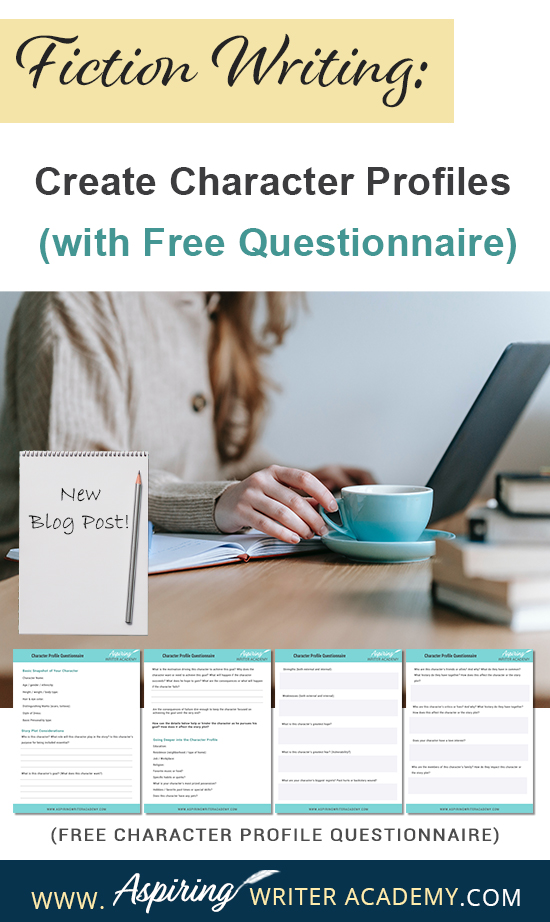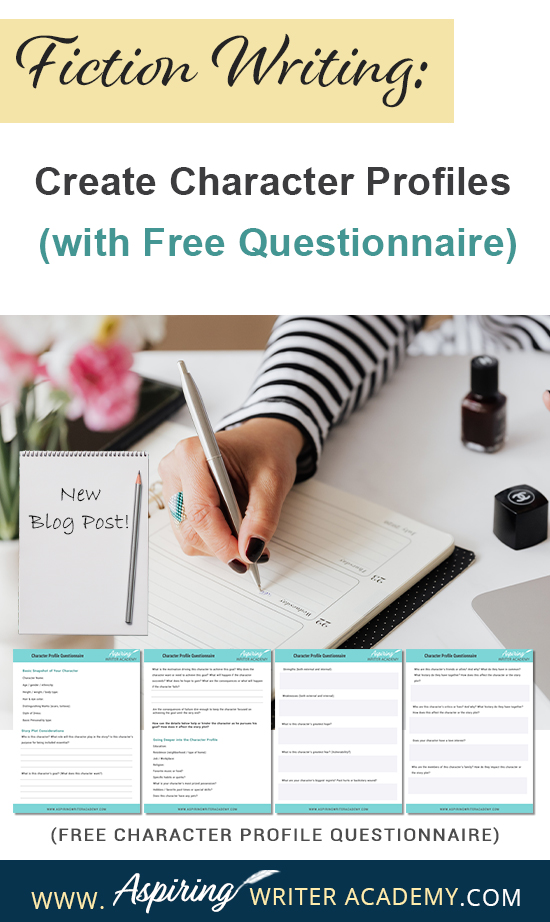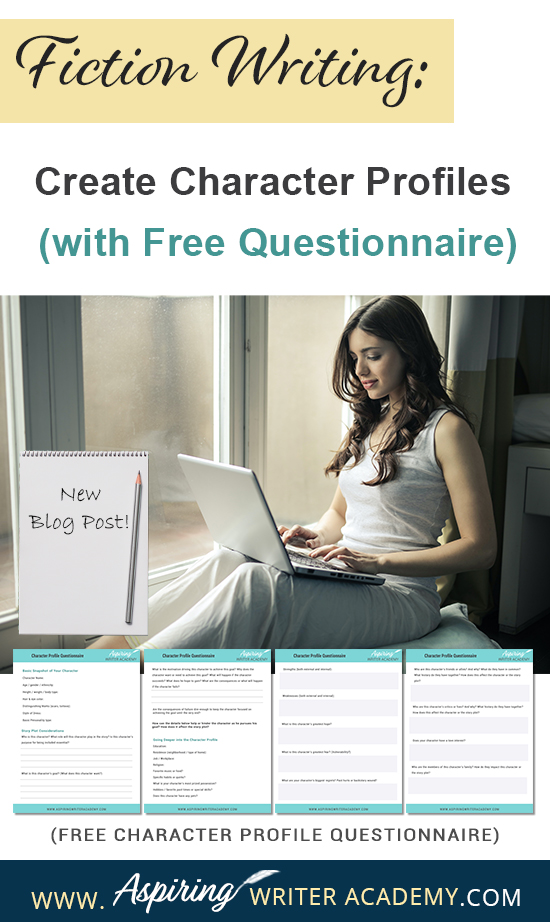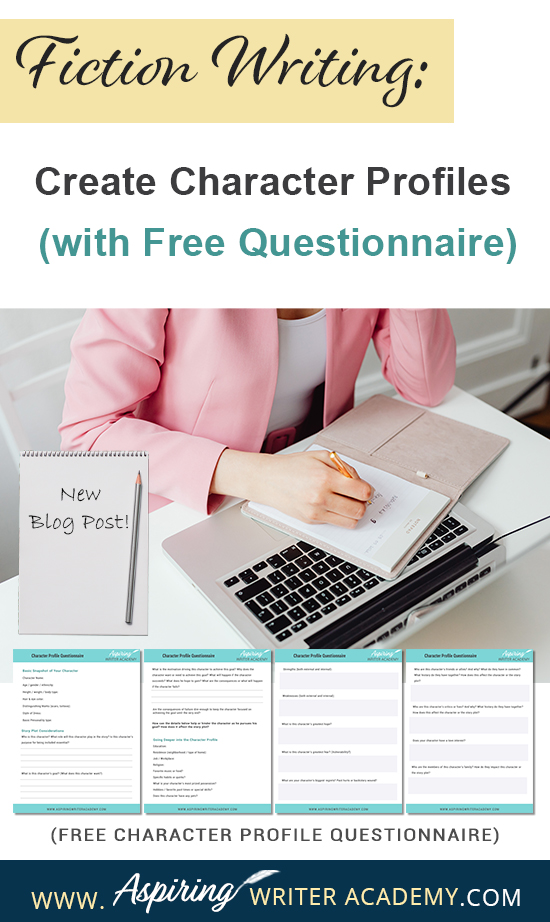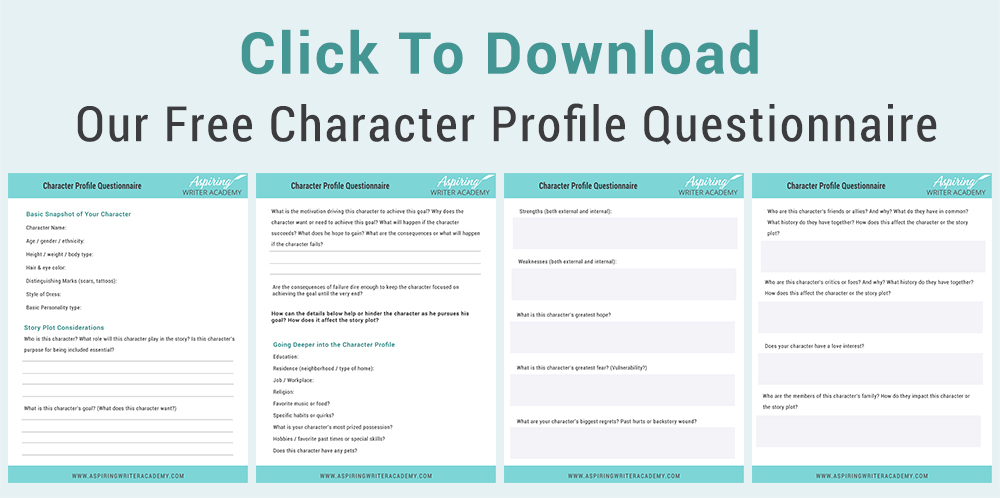Fiction Writing: Create Character Profiles (with Free Questionnaire)
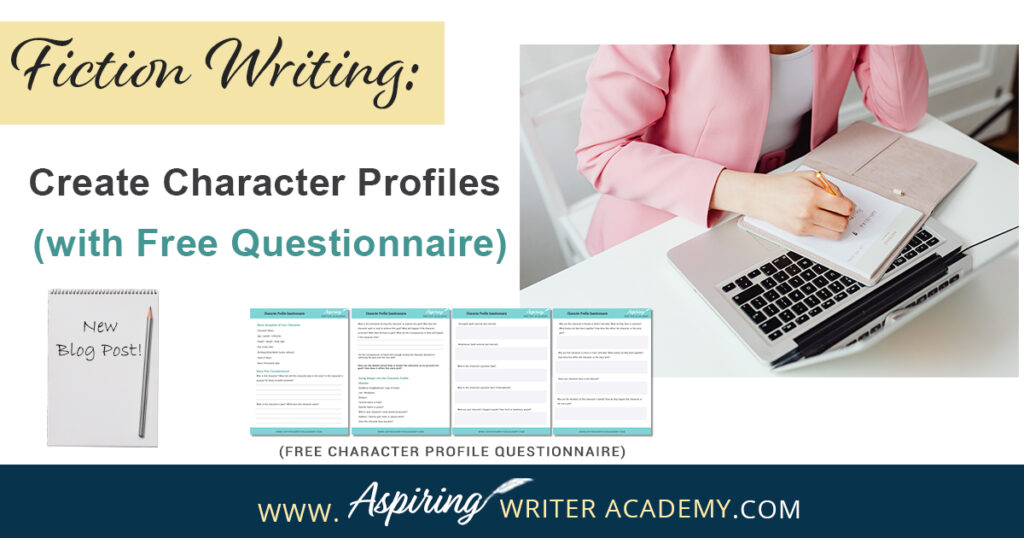
If you are planning to write a new story or need to add a character to your fiction novel, a handy fill-in-the-blank questionnaire can help define your character’s personality in a flash.
Beyond name, age, and hair color, our post, Fiction Writing: Create Character Profiles (with Free Questionnaire) helps you identify personality traits for your cast of characters that strengthen the story, intensify conflict, and enhance the plot.
How a Character Profile Questionnaire Can Help Save Time
Creating characters can be a daunting process. Some authors surround themselves with 20-page checklists, astrology charts, enneagrams, sun signs relationship compatibility books, Myers-Briggs personality tests, or leave the character creation process up to the throw of the dice.
While many of these tools can be helpful when creating characters, especially if you want to delve deeper into a particular character’s psyche, most times the only thing you need to get started are a few specific questions that will help drive the story forward.
Instead of spending hours poring over details about your characters that may not matter, first create a quick and easy character sketch to see how this individual interacts with others and the main storyline.
- Is this the right character for this story?
- Does this character’s personality need adjusting for the storyline to work?
- What if your character had a different talent or weakness or deep-seated fear than the one you originally came up with? How would that change the story?
If you create a character’s background and personality without considering the plot, (the story you want to tell), you may start writing only to later find yourself stuck and filled with frustration. In many ways you may be trying to ‘fit a square peg into a round hole’ and it just doesn’t work.
What you need is a preliminary assessment, a basic Character Profile Questionnaire.
Character Profile Questionnaire
First, let’s identify your character, so you can differentiate this one from another. These are basic questions to capture a picture of this character in your head.
Character Name:
Age / gender / ethnicity:
Height / weight / body type:
Hair & eye color:
Distinguishing Marks (scars, tattoos):
Style of Dress:
Basic Personality type:
Now let’s talk about the plot. The main character (protagonist) is who the story is about. This character takes action to pursue a goal.
The opposition character (antagonist or villain) is on a mission to stop the protagonist from achieving that goal.
All other characters in the story serve to either help or hinder the protagonist and/or antagonist. How do they help or hinder? How do their goals or actions impact the main storyline?
(Yes! Every character in the story should have their own goal, their own reason for being included in this story. A character without a purpose which impacts the plot should be cut.)
- Does your secondary character provide motivation for the main character?
- Does the secondary character’s goal align or oppose the main character’s goal?
- Is their backstory intertwined with the protagonist or antagonist’s past?
- Does your secondary character hold a secret that could shed light on the protagonist’s situation at a later point in the story? Some crucial detail that could give the protagonist the upper hand or at turn the story around in a different direction?
Who is this character? What role will this character play in the story? Is this character’s purpose for being included essential?
What is this character’s goal? (What does this character want?)
What is the motivation driving this character to achieve this goal? Why does the character want or need to achieve this goal? What will happen if the character succeeds? What does he hope to gain? What are the consequences or what will happen if the character fails?
Are the consequences dire enough to keep the character focused on achieving the goal until the very end? (The more extreme the consequences, the more tension for both your character and your reader. The higher the stakes, the better the story. Make it matter!)
Now that you have a basic picture of your character and know how this character will impact the storyline, you can now go back and flesh out your character a little more.
Thinking about your character’s goal, and what the character needs to do, what personality traits can make this character even more interesting? What strengths or weaknesses can you give this character that could help or hinder his efforts? What details could add even more tension to the story? How educated should this character be? Who should be his family members, friends, or enemies?
At this point you may want to go back and change your character’s appearance or basic personality traits or the way your character likes to dress to better fit the intended story.
More character questions to ponder:
Education:
Residence (neighborhood / type of home):
Job / Workplace:
Religion:
Favorite music or food?
Specific habits or quirks?
What is your character’s most prized possession?
Hobbies / favorite past times or special skills?
Strengths (both external and internal) Example: good at archery, feels confident, self-assured, excels in debates and wins most arguments.
Weaknesses (both external and internal) Example: often clumsy, prone to tripping over his own feet, fears being in the spotlight and public speaking, always self-conscious with poor self-esteem.
Note: A character’s weakness can be the flip side of his strength. This makes for a very relatable 3-dimensional character.
Example: If the character’s strength is that she is very good at debate, and winning every argument, her weakness may be that her aggressive behavior or eagerness to prove she is always right may drive away friends. As a result, she may feel isolated and very alone, which in turn makes her want to debate with others even more to gain interaction.
A good question to ask is: why does this character feel the need to always prove she is right? Did something happen in her background to make her feel this way? A specific incident or something that someone once said? How will her strength and weakness trip her up? And finally, how can this character learn to break this vicious cycle and better relate to people over the course of the story?
What is this character’s greatest hope?
What is this character’s greatest fear? (Vulnerability?)
What are your character’s biggest regrets? Past hurts or backstory wound?
Who are this character’s friends or allies? And why? What do they have in common? What history do they have together? How does this affect the character or the story plot?
Who are this character’s critics or foes? And why? What history do they have together? How does this affect the character or the story plot?
Does your character have a love interest?
Who are the members of this character’s family? How do they impact this character or the story plot?
Does your character have any children?
Does this character have any pets?
Are there any family secrets?
Describe how other characters view this character. Is it different than how the character views himself?
Note: Remember that the answers to these questions, if included in the story, should somehow influence the main story line, or have a specific impact on the plot. Do not give a character a fear of flying if the character never needs to fly on an airplane in the story. If the character fears being alone, then at some crucial point in the story the character should be placed in a situation where he is utterly alone and needs to face that fear and deal with it. Or perhaps the fear trips him up because he has not dealt with it but should by the end of the story. This creates a ‘character arc.’
A satisfying story often has the protagonist (main character) change from who he was at the start of the story to who he is at the end. The antagonist or sub-characters can also change. This is called a ‘character arc.’ What lesson or skill do you want your character to learn? Go back to your character’s strengths and weaknesses. What internal or external flaw do you want your characters to overcome to achieve their story goal and/or triumph over the opposition?
- If the character could not commit to a marriage at the beginning of the story, the events of the plot incrementally change the character until he is able to commit to marriage at the story’s end.
- If the character could not wield a sword at the beginning of the story, the events of the plot teach this character to get over his fear and gain the skills he needs in sword-fighting so he can defeat the villain/enemy at the end of the story using a sword.
- A character who was in heavy opposition with another at the start of the story, may learn to compromise or change his perspective due to the events of the plot and become friends with his former opponent by the story’s end.
Does the character have to have a character arc? No, the antagonist or sub-characters do not have to have a character arc. A true villain usually does not change and that is why this type of character fails at the end of the story.
What is your protagonist’s ‘character arc?’
Do any of your other characters also ‘grow’ or change during the story? What is their character arc?
When you use this Character Profile Questionnaire to help you brainstorm a character for your fictional novel, you will see how the creation of characters impacts the plot and how the plot impacts your characters. The two must be created together. That is why you should not go too deep into creating characters until you know what kind of characters you will need for the kind of story you want to tell. Many times, changes are needed to write a stronger, more interesting story. Just one change in a character’s personality or background can change everything.
Approach character creation with a flexible mindset, where you are not locked in to details that do not fit the story. With both character details and plot at the forefront of your mind, you will take your fictional story to new levels that your readers will love.
We hope you have enjoyed Fiction Writing: Create Character Profiles (with Free Questionnaire) and that you can use this basic template to brainstorm an entire cast of diversified characters for your fictional novel.
If you have any questions or would like to leave a comment below, we would love to hear from you!
If you like more help developing your story, you may wish to download our Free Brainstorming Your Story Idea Worksheet
Do you find it difficult to create compelling antagonists and villains for your stories? Do your villains feel cartoonish and unbelievable? Do they lack motivation or a specific game plan? Discover the secrets to crafting villains that will stick with your readers long after they finish your story, with our How to Create Antagonists & Villains Workbook.
This 32-page instructional workbook is packed with valuable fill-in-the-blank templates and practical advice to help you create memorable and effective antagonists and villains. Whether you're a seasoned writer or just starting out, this workbook will take your writing to the next level.
Our Goal for Aspiring Writer Academy is to help people learn how to write quality fiction, teach them to publish and promote their work, and to give them the necessary tools to pursue a writing career.

ENTER YOUR EMAIL BELOW
TO GET YOUR FREE
"Brainstorming Your Story Idea Worksheet"
7 easy fill-in-the-blank pages,
+ 2 bonus pages filled with additional story examples.
A valuable tool to develop story plots again and again.
Other Blog Posts You May Like
How to Create a Fictional Character in 5 Steps
Fiction Writing: What is the ‘Man in the Mirror Moment?’
How to Create a Diverse Cast of Characters for Your Fictional Novel
Write Your First Novel: How Do You Start?
Fiction Writing: What is a Character Arc?
How to Create Antagonists Who Are Not Villains
How to Create the Protagonist for Your Fictional Story
How to Choose Characters to Populate Your Fictional Story
Fiction Writing: How to Plot a Story where the Antagonist is an ‘Invisible Foe’
Creative Writing: 5 Ways to Strengthen a Weak Fictional Character
Fiction Writing: How to Write Compelling Dialogue
5 Questions to Create Believable Villains
Why Your Characters Need Story-Worthy Goals

is a multi-published author, speaker, and writing coach. She writes sweet contemporary, inspirational, and historical romance and loves teaching aspiring writers how to write quality fiction. Read her inspiring story of how she published her first book and launched a successful writing career.

